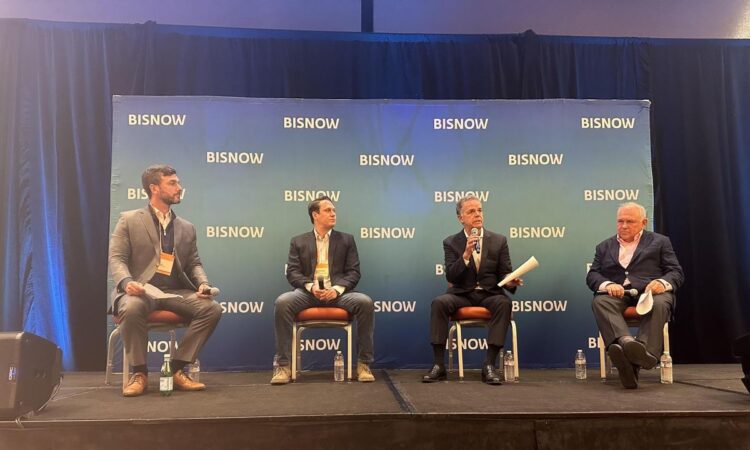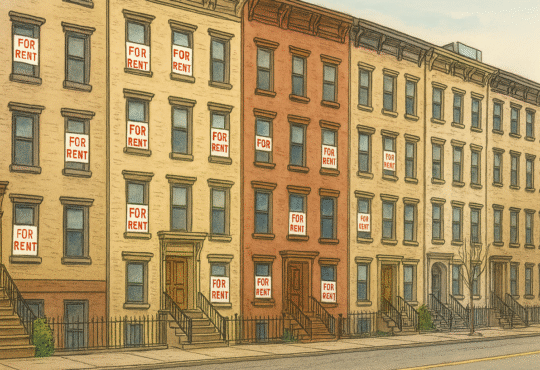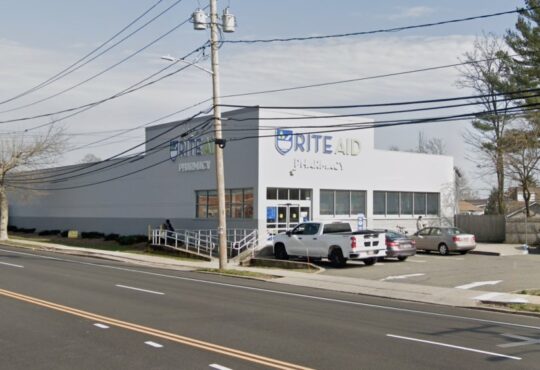
Institutional investors are tiptoeing back into the Bay Area’s multifamily market, signaling early signs of renewed momentum. Valuations have reset, and rent growth and occupancy are both improving in the famously expensive housing market.
Investors are concentrating on higher-quality assets and identifying opportunities for new multifamily development, particularly on the Peninsula and in the South Bay.

Bisnow/Bora Altunay
Allen Watkins’ Tim Kelly, Echo Valley Real Estate’s Alexander Wall, Pacific Urban Residential’s Al Pace and TruAmerica Multifamily’s Bob Hart
“When equity comes back to a market, it comes back to better markets, better assets first, right? And then when competition heats up there, it drifts to lower asset classes, lower markets and so on, so forth,” Pacific Urban Residential CEO and Vice Chairman Al Pace said during Bisnow’s Multifamily Annual Conference Northern California.
The momentum is being driven by valuations resetting by 25% to 35% below outstanding loan balances and renewed investor appetite for Bay Area multifamily as fundamentals improve, Echo Valley Real Estate Managing Principal Alexander Wall said at the event, held Oct. 21 at the Grand Hyatt San Francisco.
Equity is playing a bigger role in deals right now, with institutional investors coming back into Bay Area multifamily and interest in San Francisco approaching levels not seen since 2005.

Bisnow/Bora Altunay
Nor Cal Carpenters Union’s Jacob Adiarte, Christian Church Homes’ Cynthia Alvarez, Steinberg Hart’s Ashesh Saheba, Tenderloin Neighborhood Development Corp’s Katie Lamont and Related California’s Balint Simsik
In the last six months, the number of lenders concerned about competition doubled, while those concerned primarily about interest rates fell by almost half, Wall said.
“That should result in tightening spreads, better loan terms for all of us,” Wall said.
Agency lenders are consistently available, while banks are becoming more aggressive with their quotes as balance sheets improve, according to Pace.
The Bay Area is among the best-performing multifamily markets in the country right now as other regions work through a massive supply wave and cope with a variety of economic challenges.
Vacancy rates fell to 3% in San Francisco and the Peninsula in Q3, according to CBRE, along with 3.3% in Silicon Valley and 4.3% in the East Bay. Rent growth increased by 5.4% for San Francisco and the Peninsula, 3.7% for Silicon Valley and 1% for the East Bay.

Bisnow/Bora Altunay
PMP Management’s Amanda Cox, Avenue5 Residential’s Camille Accarino, Sares Regis Group of Northern California’s Jeff Smith, Winder Gibson Architects’ Geoff Gibson, SOM’s Mark Schwettmann and Central’s Desmond Ellis
At the same time, investors are deploying that capital more strategically. A flight to quality is shaping today’s multifamily market, with capital concentrating in major job centers and higher-performing assets.
“What’s not transacting is older, pre-1990, larger garden-style communities that were very hot 10 years ago,” TruAmerica Multifamily founder and CEO Bob Hart said.
Investors are leaning into better-located, better-built properties where rent growth and occupancy have held up more consistently.
“There’s plenty of equity around, but you have to be very selective on where you place it,” Hart said. “But I think older deals are just not getting the attention, B-minus and below, right now. That will change as cap rates normalize, rates come down.”

Bisnow/Bora Altunay
CohnReznick’s Lisa Schoepflin, Bridge Housing’s Smitha Seshadri, Jamboree Housing’s Katherine McFadden and Eden Housing’s Andrea Osgood
Multifamily in the Bay Area stands to benefit from several key policy changes. New initiatives at the state and local levels could help boost housing stock after a couple of slow years for new-home building. Both measures aim to increase the density allowed by zoning.
The San Francisco Planning Commission narrowly advanced Mayor Daniel Lurie’s family zoning plan, a program to increase housing density to meet a state-mandated target. Lurie’s plan would add capacity for roughly 36,000 homes by 2031.
The proposal now heads to the San Francisco Board of Supervisors, which leans more moderate with a centrist bloc that typically votes together, although one member was recently removed in a recall election.
At the state level, Senate Bill 79 allows upzoning around transit development sites, limits building height regulations and streamlines permitting. It also eliminates parking minimums for qualifying properties.
But even with a clearer path to building more homes, funding them remains a challenge. Deals are starting to move again, though the pace varies across submarkets.

Bisnow/Bora Altunay
Mechanical Craft Trade Unions’ Mark Burri, St. Anton Communities’ Ardie Zahedani, SummerHill Apartment Communities’ Elaine Breeze, Emerald Fund’s Marc Babsin and MBH Architects’ Tim Haley
“San Francisco is at 120% of the number of transactions they were doing on the apartment building front in 2019, which was considered a strong market,” Wall said. “East Bay, South Bay, Peninsula, they’re still at 50% to 70% of what they were doing in 2019, in terms of number of deals.”
Distressed assets are moving, but not without their own challenges.
“Lately, we’ve been buying deals that are either in foreclosure or deeds in lieu of foreclosure, and you find yourself trying to navigate around some of these very draconian costs and laws,” Hart said.
With high transfer taxes in some regions, the extra costs can make some of these deals infeasible. Developers are using legal strategies to work around this, such as doing a deed-in-lieu-of-foreclosure transaction with a simultaneous friendly foreclosure. Borrowers are leveraging their size and reputation to get cheaper loans.
The next phase of the cycle may not look like the last one. But money is flowing again, and the Bay Area is back on investors’ maps.






